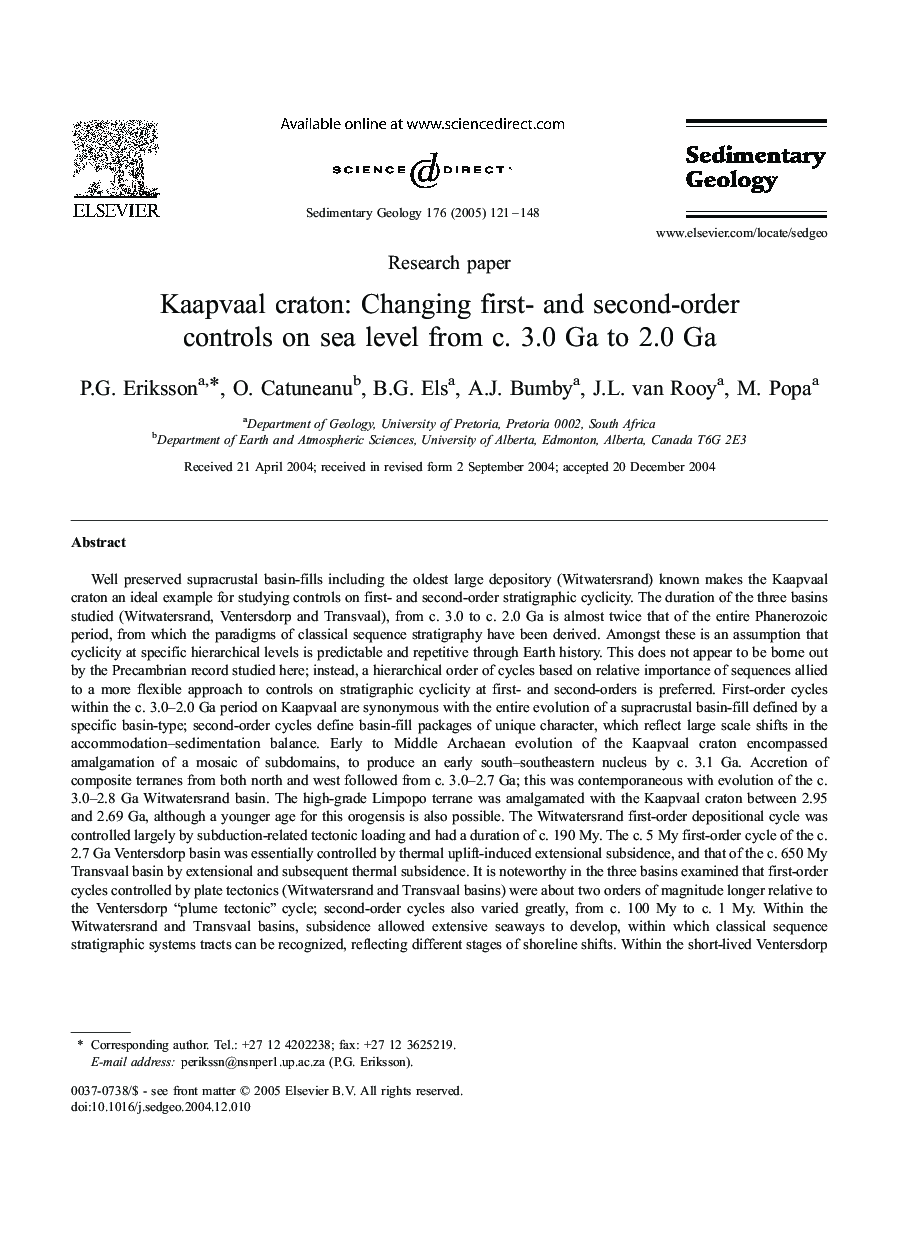| کد مقاله | کد نشریه | سال انتشار | مقاله انگلیسی | نسخه تمام متن |
|---|---|---|---|---|
| 9526213 | 1636207 | 2005 | 28 صفحه PDF | دانلود رایگان |
عنوان انگلیسی مقاله ISI
Kaapvaal craton: Changing first- and second-order controls on sea level from c. 3.0 Ga to 2.0 Ga
دانلود مقاله + سفارش ترجمه
دانلود مقاله ISI انگلیسی
رایگان برای ایرانیان
کلمات کلیدی
موضوعات مرتبط
مهندسی و علوم پایه
علوم زمین و سیارات
فرآیندهای سطح زمین
پیش نمایش صفحه اول مقاله

چکیده انگلیسی
Well preserved supracrustal basin-fills including the oldest large depository (Witwatersrand) known makes the Kaapvaal craton an ideal example for studying controls on first- and second-order stratigraphic cyclicity. The duration of the three basins studied (Witwatersrand, Ventersdorp and Transvaal), from c. 3.0 to c. 2.0 Ga is almost twice that of the entire Phanerozoic period, from which the paradigms of classical sequence stratigraphy have been derived. Amongst these is an assumption that cyclicity at specific hierarchical levels is predictable and repetitive through Earth history. This does not appear to be borne out by the Precambrian record studied here; instead, a hierarchical order of cycles based on relative importance of sequences allied to a more flexible approach to controls on stratigraphic cyclicity at first- and second-orders is preferred. First-order cycles within the c. 3.0-2.0 Ga period on Kaapvaal are synonymous with the entire evolution of a supracrustal basin-fill defined by a specific basin-type; second-order cycles define basin-fill packages of unique character, which reflect large scale shifts in the accommodation-sedimentation balance. Early to Middle Archaean evolution of the Kaapvaal craton encompassed amalgamation of a mosaic of subdomains, to produce an early south-southeastern nucleus by c. 3.1 Ga. Accretion of composite terranes from both north and west followed from c. 3.0-2.7 Ga; this was contemporaneous with evolution of the c. 3.0-2.8 Ga Witwatersrand basin. The high-grade Limpopo terrane was amalgamated with the Kaapvaal craton between 2.95 and 2.69 Ga, although a younger age for this orogensis is also possible. The Witwatersrand first-order depositional cycle was controlled largely by subduction-related tectonic loading and had a duration of c. 190 My. The c. 5 My first-order cycle of the c. 2.7 Ga Ventersdorp basin was essentially controlled by thermal uplift-induced extensional subsidence, and that of the c. 650 My Transvaal basin by extensional and subsequent thermal subsidence. It is noteworthy in the three basins examined that first-order cycles controlled by plate tectonics (Witwatersrand and Transvaal basins) were about two orders of magnitude longer relative to the Ventersdorp “plume tectonic” cycle; second-order cycles also varied greatly, from c. 100 My to c. 1 My. Within the Witwatersrand and Transvaal basins, subsidence allowed extensive seaways to develop, within which classical sequence stratigraphic systems tracts can be recognized, reflecting different stages of shoreline shifts. Within the short-lived Ventersdorp continental basin system, sedimentological criteria can be used to discriminate high and low accommodation systems tracts. The Transvaal first-order cycle was terminated at c. 2.0 Ga by the Bushveld Complex plume event.
ناشر
Database: Elsevier - ScienceDirect (ساینس دایرکت)
Journal: Sedimentary Geology - Volume 176, Issues 1â2, 29 April 2005, Pages 121-148
Journal: Sedimentary Geology - Volume 176, Issues 1â2, 29 April 2005, Pages 121-148
نویسندگان
P.G. Eriksson, O. Catuneanu, B.G. Els, A.J. Bumby, J.L. van Rooy, M. Popa,